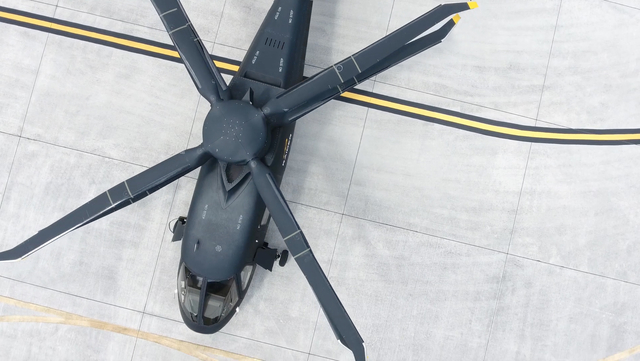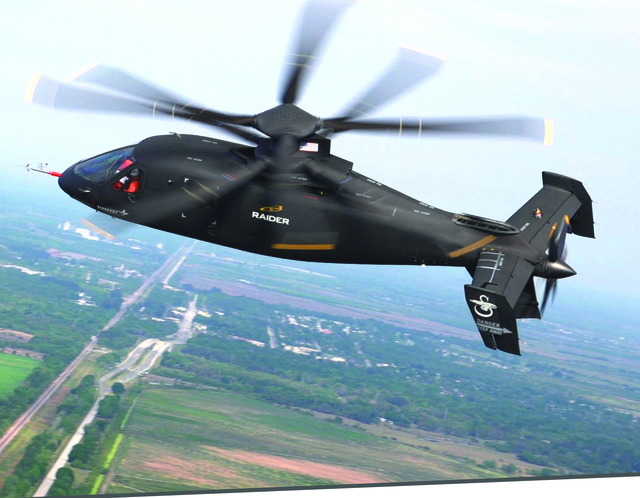According to test pilot lore, when Sikorsky tried flying its first advancing blade concept on the experimental S-69 rotorcraft – a system with two stacked blades rotating in opposite directions– the machine jackhammered so roughly that it rattled loose a gold crown in the pilot’s mouth. Sikorsky cannot confirm that legend, but acknowledges that its 1970s-era co-axial compound helicopter, which was powered by four jet engines and required two pilots to maintain control, was not a smooth ride.
“The S-69’s vibration was so violent that the crew could not read the instrument panel,” says Chris Van Buiten, vice-president of Sikorsky Innovations.
Decades later, advancements in Sikorsky’s advancing blade concept, made via the company’s Collier Trophy-winning X2 experimental rotorcraft, have reduced vibrations dramatically and could find their way into active military service as part of a follow-on rotorcraft, the S-97 Raider. The company is set to resume testing of the aircraft this spring, after one of its demonstrators suffered a hard landing last August, grounding the programme for more than six months. But when the S-97 Raider resumes flight it will stand alone as the only clean-sheet helicopter with flight hours and performance to fulfil the US Army’s vision of a scout and light attack helicopter: the so-called Future Vertical Lift (FVL) Capability Set One.
The service has done without a scout helicopter since retiring the Bell OH-58 Kiowa in 2017, and this opportunity is not lost on Sikorsky. “An intense focus for us is the Cap Set One FVL. We think that’s a great starting point for us,” Van Buiten says. “We see applications for the S-97 for troop assault, special ops, recon light attack, search and rescue and, in the future, an optimally piloted aircraft operating with two, one, or zero crew.”
The aircraft has a gross weight of about 5,440kg (12,000lb) and capacity for a pilot, co-pilot and six passengers. Its planned payload would include Lockheed Martin AGM-114 Hellfire air-to-surface missiles, 2.75in rockets, plus 7.62mm and .50cal guns.
Officially, Capability Set One is not requested by the army until 2030 and after the delivery of Capability Set Three, which is the replacement for the Sikorsky UH-60 Black Hawk and Boeing AH-64 Apache. However, repeated public remarks by US generals show that ground forces may push the scout helicopter to the top of their priorities, if given the chance and the funding by Congress.
"It is still readily apparent that the most critical gap right now for the army is a light-armed reconnaissance helicopter that has the ability to fight for information about terrain and the enemy, that enables the ground force commanders, that gives decision space and manoeuvre room and reaction time," Maj Gen William Gayler, Commanding General, US Army Aviation Centre of Excellence, said at the Army Aviation Association of America summit in 2017. “We are certainly looking for every option and every opportunity that we can to field as quickly as possible the Capability Set One, the light-attack reconnaissance."

Sikorsky
Higher, hotter, faster, further – with finesse
The S-97 Raider’s advancing blade concept features a pair of rigid, contra-rotating co-axial rotors – similar in some ways to the Russian Kamov Ka-50 light-attack helicopter. Contra-rotating blades eliminate the need for a power-sapping tail rotor to counteract torque. And together they provide balanced lift. On any rotorcraft an individual blade is either advancing – that is, sweeping in the direction of the aircraft’s travel – or retreating, and the relative airspeed difference means advancing blades produce more lift than retreating blades. But with a contra-rotating pair of rotors, an advancing blade on one side of the aircraft is naturally balanced by an advancing blade on the other.
Thus the Raider, with contra-rotating and rigid blades, does away with the swash plate mechanism of traditional single-rotor designs, which increases blade pitch in retreat and decreases it in advance, to balance their lift. The pair of rigid rotors – there is some feathering owing to flex in their structure – can run just 36in apart and, since there is neither need nor facility to increase the pitch of retreating blades, overall drag is reduced.
As in any compound helicopter, propulsion is provided principally by the tail rotor. The main rotors are mostly about lift and manoeuvrability, so they can thus run slower – with less drag – than they would if having to provide both lift and propulsion. “At top speed the rotor provides lift equal to weight, but virtually no thrust. The thrust all comes from the propeller,” says Van Buiten. “In low- and mid-speed flight the pilot can choose a balance between the propeller and the rotor for thrust, although there is an automated mode. In the automated mode the flight controls choose the most efficient balance.”
But the pusher propeller can also be disengaged via a clutch. “Say we get combat damage and lose the prop. We don’t need the prop,” Van Buiten says. “We’ve flown the helicopter at 150kt [277km/h] with the prop disengaged.”
When the Raider resumes testing this spring Sikorsky plans to first probe the outer limits of its speed. “The programme has completed low-speed handling qualities evaluation and expanded the speed envelope to 150kt,” says Raider lead test pilot Bill Fell. “We plan to increase the speed envelope to 180kt, then 200kt and then to 220kt.” The Raider’s predecessor, the X2, reached a top speed of 250kt in 2010.

Sikorsky
Sikorsky will then test load factors up to 3g on the Raider, says Fell. “We will do a series of turns, pull-ups, and push-overs.”
The S-97 has completed 20h of flight testing and a couple of hundred hours of ground testing, according to the company. Eventually, the rotorcraft will test its ability to hover out of ground effect at 6,000ft, at up to 35°C (95°F). Sikorsky estimates its combat radius to be 205nm (380km).
Manoeuvrable, but marketable?
Fell says the S-97 manoeuvres differently than a conventional helicopter. “The prop provides a thrust vector independent of the main rotor. This allows the pilot to hover nose up with positive propeller thrust or nose down with negative prop thrust,” he says. “It also allows the pilot to dip the rotor or nose attitude to accelerate, or accelerate level using the prop.”
The rigid rotor and stiff properties of the advancing-blade concept also allow the helicopter to transfer more engine power into greater acceleration and less rotor lag. “The greater acceleration and reduced lag create a sports car or fighter feel to the Raider,” says Fell.
Sikorsky believes its nimble helicopter could have special operations uses, based on its long range, relatively quiet flight and lack of downwash. The helicopter could be a replacement for the US Special Operations Command’s Boeing MH-6 Little Bird light-assault helicopter. And, its relatively small rotor diameter – 10.7m (35ft) – could be useful in navigating between tall buildings during urban firefights. By comparison, the Little Bird’s rotor diameter is just over 8.2m, and the Black Hawk’s 16.5m.
“The combination of the speed, manoeuvrability and acoustics results in very dramatic reductions in hits that a Raider would take in a battlefield,” Van Buiten says, noting internal company simulations. “It’s just much more survivable.”
The company says it is also rigging the helicopter for unmanned autonomous flight: an ability that could be useful for flying scouting missions in dangerous airspace.
Yet, however impressive the S-97 Raider’s performance may sound, its future is tenuous without an army production contract. And those have been elusive, with the service cancelling numerous procurement plans of clean-sheet designs over the years, including the Boeing-Sikorsky RAH-66 Comanche scout in 2004.
“The development programmes have all been cancelled, restarted and re-cancelled again,” says Mike Hirschberg, executive director of the American Helicopter Society International. “The army has been back and forth of what their requirement is, Capability Set One or Three.”
That creates a lot of uncertainty for Sikorsky and its 30 partner suppliers in the Raider programme, which have together invested more than $200 million. Partner suppliers are not guaranteed production contracts should an S-97 programme get started by the army, but are presumed to have an advantage because of their inside knowledge of the helicopter, according to Van Buiten. Sikorsky also invested $50 million in developing the X2 demonstrator.
In fact, the whole industry appears to be holding its breath for the army to make its buying decisions, as equipment replacement cycles in the USA and Europe come to an end over the next decade, notes Ray Jaworowski, senior aerospace analyst with Forecast International. “If you look at Future Vertical Lift as a whole, not just Capability Set One, but all five levels, it’s really hard to understate how important Future Vertical Lift is to the military market.
“Starting in the late 2020s, maybe around 2027, you see a big decline [in helicopter purchases] and the market doesn’t start to ramp up until Future Vertical Lift starts to ramp up in the 2030s.”
Source: Flight International






















